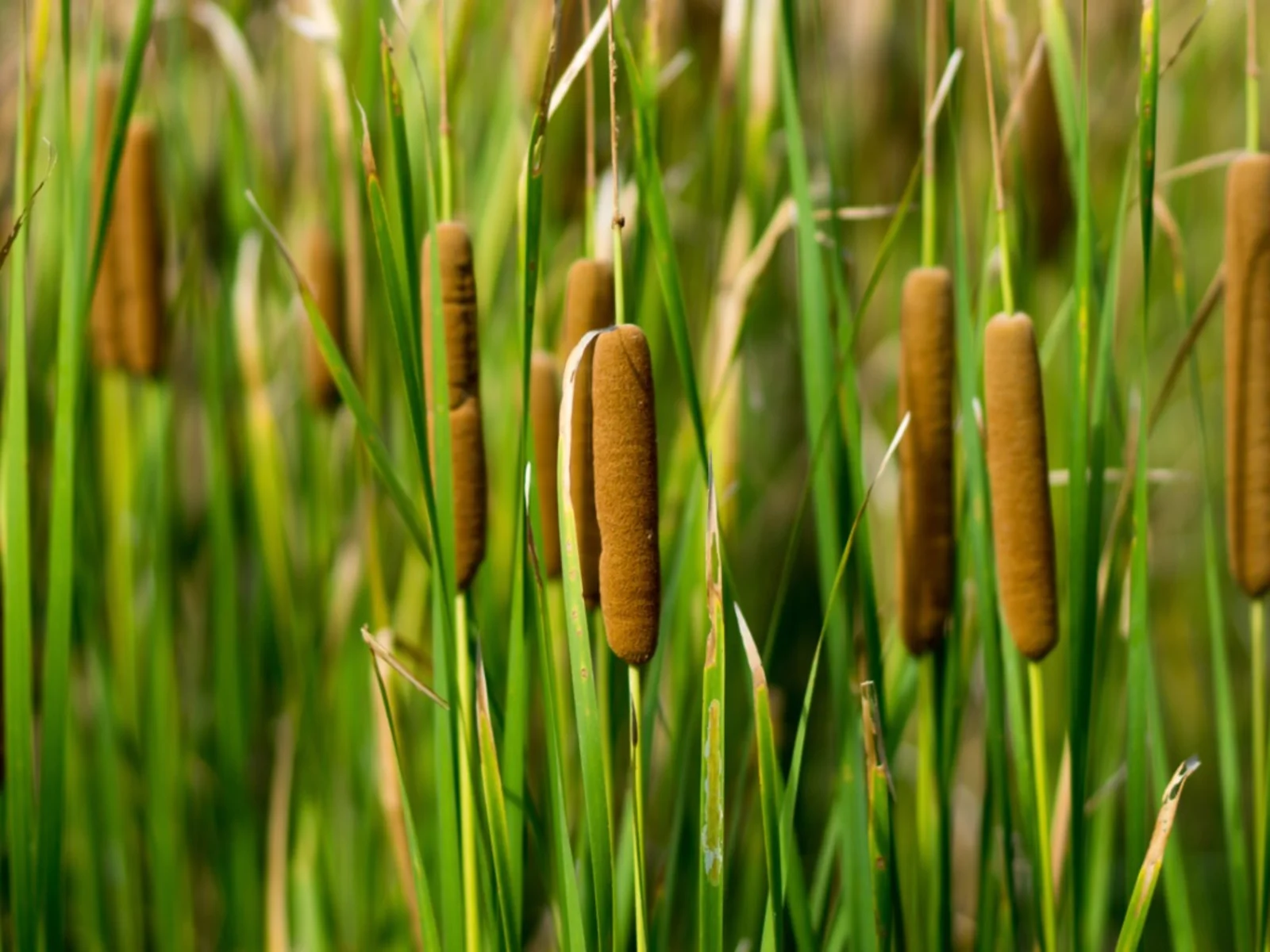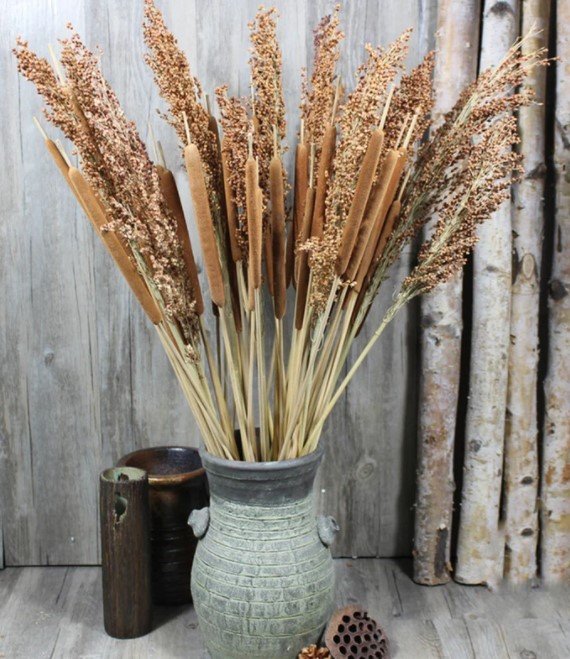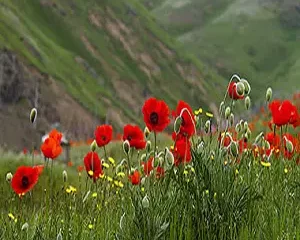Bulrush plant specifications
- English names : common bulrush, Broadleaf cattail, common cattail, great reedmace, coopers reed
- Scientific name : TYPHA LATIFOLIA
- Family : TYPHACEAE
- Plant Type : Perennial, herbaceous
- Mature Size : 5-10 ft. tall, 18-24 in. wide
- Sun Exposure : Full, partial
- Soil Type : Moist, loamy
- Bloom Time : Summer
- Flower Color : Brown
- Native to the region : North and South America, Europe, Asia and Africa
You might know common bulrush ( Typha latifolia ) as cattails. These perennial aquatic plants are widely associated with growing in shallow waters in boggy marshes and wetland areas across temperate regions in North America.
Bulrush have an upright growth habit with basal leaves, a long, narrow upright stem, and a tall cylindrical inflorescence. With the right conditions, these fast-growing plants can reach up to ten feet tall. They have a rhizomatous root system and spread rapidly to form attractive thick clumps. The tall, dense clumps provide cover and nutrition for wildlife. bulrush plant
read more : Everything about pampas grass : How to Plant & care for them

In garden landscapes, bulrush are well suited for growing around ponds, in water gardens, or areas prone to flooding; they can easily grow in water up to ten inches deep. They can also be a good choice for erosion control on wet slopes, and they make a great privacy screen too. The attractive stems are frequently added to flower arrangements in fresh or dried form.
When planting a cattail, make sure you select a species such as Typha latifolia, which is native to parts of the United States instead of an introduced species that can become invasive.
read more : Everything about giant reed : How to Plant & care for them
Iran dried bulrush plant
Dried bulrush plant has many usages in interior design due to its unique beauty. The beauty and reasonable price of dried bulrush have caused it to have many fans in the world, and the sale and purchase of dried bulrush for export has brought great profits to dried bulrush exporters and traders active in this field. bulrush plant

read more : Drying natural flowers | Introducing 8 wonderful ways to dry flowers
Cattail Plant Care
With the right conditions, in no time at all you can develop a cattail colony that requires little maintenance. They do, of course, need the right amount of moisture, and they can become invasive if not kept in check in bottomless containers or something similar. Their spreading rhizomes can be difficult to remove once established. However, they are a great choice in boggy environments where other plants struggle to survive.
Bulrush need no help getting through even harsh winters in their native climate. These hardy plants will come back reliably year after year.
Warning
Non-native bulrush are considered an invasive species in some areas because they can grow aggressively through spreading rhizomes. They have been known to grow in dense clumps that affect irrigation, impede waterways, and choke out other plants in the area. Keeping them well-controlled is vital to maintaining a lovely habitat around ponds and streams. bulrush plant
-
Light
Bulrush need full sun or partial shade to thrive. They can’t survive in full shade.
-
Soil
These plants benefit from rich, loamy soil that contains plenty of organic matter. They can, however, grow in most soil types.
read more : Everything about palm plant : How to Plant & care for them
-
Water
As you would expect from a marshland species, bulrush need a lot of moisture to thrive, and this is the most vital element of their care. The soil should be kept wet, which is why they do best in areas where this happens naturally. These plants can thrive in standing water.
-
Temperature and Humidity
Bulrush are most commonly found in temperate regions of North America, but they can also grow in subtropical and elevated tropical regions. Although young shoots don’t cope with frost well, established bulrush can handle harsh winters in their dormant state.
-
Fertilizer
Fertilizing bulrush isn’t generally required or recommended.
Types of Bulrush
Three other cattail species that might interest the home gardener, but they are native to Europe and Asia and as such might become invasive if not controlled :
- Dwarf bulrush ( T. minima ) is a dwarf variety of cattail that grows only two feet tall with interesting, rounded catkins.
- Graceful cattail ( T. laxmannii ) has spiraling threads on the end of its leaves and striking, golden catkins that are about the size of a walnut.
- Narrowleaf cattail ( T. angustifolia ) offers exactly what the name suggests; narrow leaves as opposed to the broader leaves of the other varieties. It can become invasive.
Pruning
It’s advisable to prune back cattail plants in bogs during the fall when their growth slows down. Cut the bulrush with sharp pruning shears about eight inches above the surface of the water they’re standing in, or down to the ground if they are not in standing water. New growth will appear in the spring.
read more : Everything about lunaria plant : How to Plant & care for them
Propagating Bulrush Plants
Bulrush can self-seed freely and spread through their rhizomes. These rhizomes make it easy to propagate if you want to add a new cluster of plants to a different large landscape area. Young shoots can also be divided in the spring when they are between five and ten inches tall.
Dig up the plants with a shovel, making sure a decent amount of undamaged root is attached.
Divide the plants into manageable sections and plant them in a new suitable wet location, near a pond or another location where they get flooded and stand up to 12 inches deep in water.
How to Grow Common Bulrush Plants From Seed
If growing bulrush from seeds, they need a lot of water for successful germination. They should be sown on the surface of the soil and kept very moist, to the point of being soggy. Sowing them at the edge of a pond or other marshy area makes this process much easier for the home gardener.
If you are starting cattail seeds indoors, begin by soaking the seeds for 24 hours, then cleaning away the cottony debris that often surrounds them. Let the seeds dry, then press them on top of a two-inch container filled with a mixture of seed-starting compost and coarse sand.
Cover them to a depth of 1/4 inch with compost. Cover the plants with a plastic dome and use a germination mat set to 100 degrees Fahrenheit to provide ample warmth. Water at least once a day with a spray bottle to ensure proper moisture. Germination takes about two weeks.
Transplant strong seedlings into the soil in early autumn, preferably right after rainfall so the soil is very moist.
Common Pests
Bulrush don’t face the typical insects that many other plants do. Instead, they are often eaten by creatures of much larger size, such as crayfish or muskrats. Because bulrush are so prolific, animal grazing shouldn’t be an issue.
Notice : This article translated by google form Persian language. If you have any question or need more information please contact us or add a comment at the bottom of this page.


0 Comments